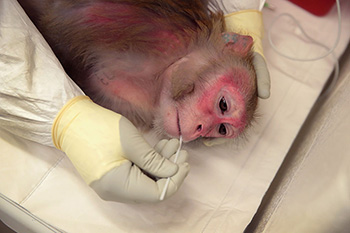中国科学家已成功将3D打印血管植入恒河猴体内,这标志着在打印血管及其他器官用于人类移植方面迈出了重要的一步。
Chinese scientists have successfully implanted 3D printed blood vessels made from stem cells into rhesus monkeys, marking an important step towards printing blood vessels and other organs for human transplants.
邓迪大学(Dundee University)的教授阿尔弗雷德.库斯基耶里爵士(Sir Alfred Cuschieri)表示:“这一开创性研究将改变再生医学的发展之路。”库斯基耶里爵士曾多次访问四川蓝光英诺生物科技公司(Revotek)的科研团队,希望结成国际合作伙伴关系。“他们比西方领先很多。”
“It is groundbreaking work that will change the way regenerative medicine will develop,” said Sir Alfred Cuschieri, a professor at Dundee university, who has visited the scientific team from biotech group Sichuan Revotek several times and hopes to bring it into international partnerships. “They are well ahead of the west.”
世界各地的科学家都在争相构建生物合成器官,它可以弥补人类捐献器官的短缺。一种技术是用小型3D打印机构建活细胞。最近有报道称俄罗斯生物科技集团3D Bioprinting Solutions已成功将3D打印甲状腺植入一只老鼠体内。
Scientists around the world are racing to construct biosynthetic organs that could begin to make up for the shortage of organs from human donors. One technique is to lay down living cells through a miniaturised 3D printer. Russian biotechnology group 3D Bioprinting Solutions recently reported that it had successfully transplanted a 3D-printed thyroid gland into a mouse.
位于中国西南省份四川的蓝光英诺用装满干细胞“墨汁”——干细胞可以分化为机体的任何一种细胞——的3D打印机打印出约2厘米长的血管样本,然后将这些血管植入30只恒河猴的胸腔中。
Revotek, based in the southwestern province of Sichuan, used a 3D printer filled with ‘ink’ made from stem cells — building blocks that can become any cell in the body — to print prototype blood vessels about 2cm long. These were then implanted into the chests of 30 rhesus monkeys.
据蓝光英诺介绍,植入一个月后,人工血管中的干细胞生长成天然血管所需的多种细胞,随着时间推移,这些细胞与恒河猴的原生血管已变得“不可区分”。
One month after implantation, the stem cells in the artificial vessels had grown into the different kinds of cells that make up natural blood vessels, and over time they became “indistinguishable” from the monkeys’ original vessels, according to Revotek.
蓝光英诺该项目首席科学家康裕建(James Kang)表示,全球每年有1.56亿人需要人工血管或血管支持结构,这项研究能为他们带来福音。康裕建上世纪90年代开始在美国从事干细胞研究。
James Kang, lead scientist on the Revotek project who began working on stem cells in the US in the 1990s, said the research could benefit the 156m people every year worldwide who need artificial blood vessels or vessel support structures.
伦敦机械工程师协会(Institution of Mechanical Engineers)医疗保健主管海伦.米斯(Helen Meese)表示蓝光英诺的研究“对于全球生物科技界是一项令人振奋的成果”。她同时表示:“迄今为止的大部分研究都是在实验室进行的小规模测试。下一个重大挑战是扩大规模,而他们的研究是朝着这一方向迈出的一大步。”
Helen Meese, head of healthcare at the Institution of Mechanical Engineers in London, said Revotek’s work was a “very exciting result for the global biotech community”. She added: “Most of the research so far has been small-scale testing in laboratories. Scaling up is the next big challenge, and this is a big step in that direction.”
田纳西大学(University of Tennessee)分子资源中心(Molecular Resource Center)执行理事唐纳德.托马森(Donald Thomason)在蓝光英诺发表成果时表示:“虽然世界各地都在发展生物材料3D打印,但这个项目的成果……是我见过最成熟的。”
Donald Thomason, executive director of the Molecular Resource Center at the University of Tennessee, said when Revotek presented its results: “Although the 3D printing of biological materials is developing around the world, this project’s result . . . is the most mature I’ve seen.
“有些移植成本非常高……但用自体取出的干细胞,从长远来看,成本应该会低很多。”
“The costs of some transplants are very high . . . but using stem cells harvested from the same body, in the long term, the costs should be much lower.”
米斯表示该成果有待发布,实验步骤也要在其他实验室重复进行。她估计至少要20年时间才能将心脏或肾脏等更复杂的3D打印器官移植到人类病患体内。
Ms Meese said the results needed to be published and the procedure replicated by labs elsewhere. She estimated that it would take 20 years or more before more complex 3D-printed organs such as hearts or kidneys were transplanted into human patients.
蓝光英诺现在计划用更多猴子样本进行第二次试验。
Revotek now plans to run a second trial with a larger sample of monkeys.
